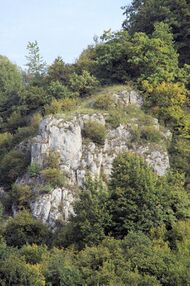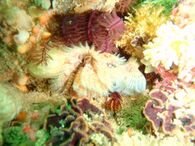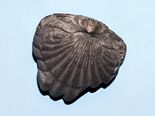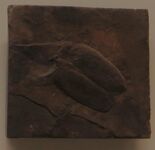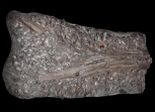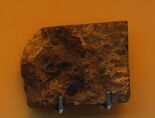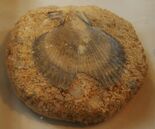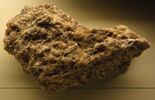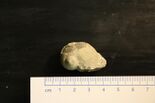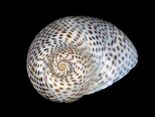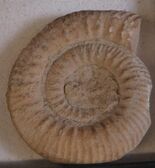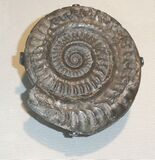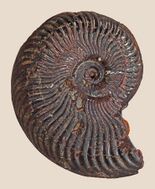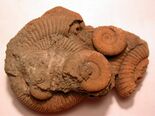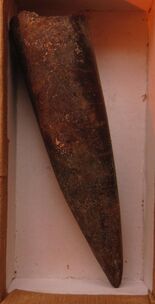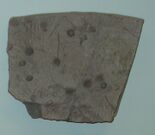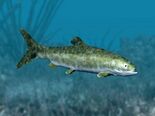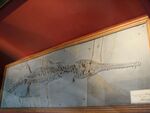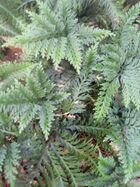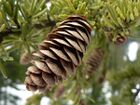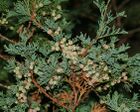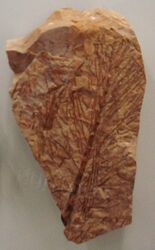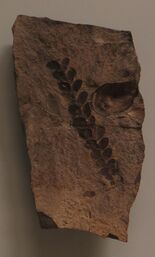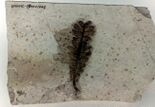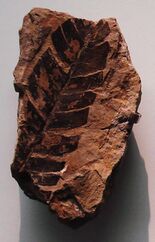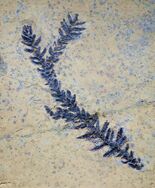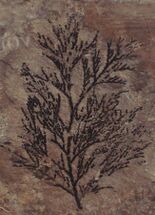Earth:Dactyliocerassandstein Formation
| Epsilonkalksandstein Formation Stratigraphic range: Early Toarcian ~180 Ma | |
|---|---|
 Upper part of the Keilberg Limestone Quarry in Regensburg, which has boreholes with 5-metre (16 ft) profile of the formation | |
| Type | Geological formation |
| Unit of | Schwarzjura Group ("Black Jurassic") |
| Underlies |
|
| Overlies |
|
| Thickness | Up to 60 metres (200 ft) |
| Lithology | |
| Primary | Sandstone, Limestone |
| Other |
|
| Location | |
| Coordinates | 48°51'02.3"N, 12°45'02.2"E |
| Region | Bavaria |
| Country | Germany |
| Type section | |
| Named for | Its abundance of Dactylioceras commune and Dactylioceras annulatum |
| Named by | Ludwig von Ammon (as an informal unit)[1] |
| Year defined | 1875 |
The Dactyliocerassandstein Formation (also known as Epsilonkalksandstein Formation) is a Lower Jurassic (Lower Toarcian) geologic formation primarily located in Bavaria, Germany .[1] The Formation appears on places like Bruck in der Oberpfalz, the north-east of the Banz Abbey, Wittelshofen, Regensburg and Bodenwöhr. In the astly foreland it extends from the Kulmbach area via Bayreuth, Creussen, Hirschau and Amberg to Schwandorf. Its southernmost known occurrences seems to be Schwandorf himself and Haselbach, although is also found at Bachhausen, far at the south.[2] Is composed mostly by clusters of clay sandstone and sand-lime stone facies (shale, slightly bituminous in layers, and sandstone, lias sand, sand marl, marl, oolithic limestone and sand-lime banks) occurs only in the south-east of the northern Bavarian Jura region, for example at the edge of the granite Bavarian forest. On its northern edge, it is noticeably less tectonically disturbed in the Bodenwoehr basin near Sollbach. On the western edge it only appears on the Keilberg (east of Regensburg) and Irlbach (NE Regensburg).[2] It is a deposit recovered It is the same age as the marine Posidonia Shale, and has been identified as part of it in many sources.[3][4][5] The formal relationship between the two layers, however, is undefined; the Posidonia Shale is sometimes described as a different coeval unit or a changed sector, possibly with more terrestrial influence.[6][7][8] The extent of the major outcrop of the formation is not clearly delimited. It has been observed in Straßkirchen, Bogen, Straubing; its westernmost points are in Pfatter and a deep outcrop in Keilberg.[9][10] The name of the Formation derives from the presence of Dactylioceras commune and annulatum, as part of the Monotis-Dactylioceras Bed present along the Lower Toarcian deposits on Bavaria.[11] This Dactylioceras bank was recognized as the facies of the peel-poor bank, and was not destroyed in the Bifrons regression, hence the acummulation of Ammonites and the name of the layer.[11] Is even preserved in the coastal area of the sand deposit, when the regression probably increased the transportability of the water so large that the thin, light Pseudomonotis (=Arctotis) shells were moved, but not the heavy ones, which at that time already contained sands filled of Dactylioceras specimens.[11]
Geology
The geology of the northern city of Regensburg at the Keilberg Quarry is determined by the north–south Kilberg Fault of the Keilberg Rift, the main fault in the Regensburg Basin.[12] Developed by the sinking of the southern German Jura Plateau during the Miocene, it separates the higher, older crystallization of the Moldanubian Basement from the Lower Jurassic chalk complex of the eastern Franconian Jura which includes the Epsilonkalksandstein Formation.[13] The oldest marine documentation near Regensburg is the Hettangian Arietites Sandstone, which indicates that the gradual south-eastern advance of the sea was not uninterrupted at the beginning: many gaps in layers, the formation of channels and transgression, and processing horizons.[13][jargon] The Pliensbachian is recovered[jargon] locally with a series of red-iron facies, probably deposited near a beach in a series of very thin, changing layers.[13] During the late Pliensbachian, the zone became a relatively narrow, flat deposit area which flooded during the early Toarcian (except on the east of the Keilberg Quarry); it reemerged during the Bifrons substage with a changing coastline, thanks to rhythmic uplifts and subsidence of older Paleozoic and Triassic siliciclastic deposits from the east.[13] The granites and gneisses resulting from crystallization were eroded from the Paleozoic exposures on the east, and were deposited on the Jurassic prograded alluvial nearshore sandstone from the Epsilonkalksandstein Formation to the Bajocian layers.[13] The younger limes of the Late Jurassic emerge further west, covering the fault, and are mined in the southern part of the Keilberg Quarry; they are visible from a distance.[13] The Callovian and Tithonian limestones which overspread the local slopes contain substantial chert.[14] The narrow lias band on the Keilberg emerged on the Cenozoic as a result of sinking at the Keilberg Rift jump: in the south is the Upper Lias in the Tegernheim Gorge as a result of the (Oligocene?) pressure of the granite from the west, accompanied by a shifting of the leaves and by partial tearing of the upper lias, dragged almost up to a vertical erection (80 ° SW). The oolithic Limestone banks were severely shattered, which manifests itself in abundant Calcite-healed fissures, limonistic veins and armor formation.[2] This can also be seen in the upper limestone marl and marl limestone. In the north, the Oberlias south of Irlbach is clearly erect, but hardly influenced by tectonics.[2] The slopes of the Keilberg Quarry are partially covered by till, soliflucted rubble and loess from the Würm glaciation. The poor deposition suggests that the ice sheets, like those of the rest of the Quaternary glaciation, never crossed the Regensburg area; there was an ice-free corridor between the Fennoscandian ice sheet and the Alpine glaciers.[13][14]
Paleogeography
On the Jurassic the zone of the east of Regensburg (mostly on the Tegernheim Gorge) is well known, and shows constant changes and evolution.[15][16] On the lower jurassic (Lias) a Sea Wedge pushed from the north into the area of Regensburg and formed a Lagoon in which sands and an Iron Ore facies near the coast were deposited ("Keilbergsandstein" and "Arietitessandstein" mostly on the Hettangian, Sinemurian and its maximum extension on the Toarcian Epsilonkalksandstein).[15][16] Towards the Toarcian the sea gradually advanced to the southeast (Keilberg to the Danube outcrops), so the marine influence in Regensburg increased until the Bifrons Substage of the Toarcian, where the sandstones return and cover all the deposits.[15][16] It is even more difficult to judge the distance from the coast than in the case of the marine (Hettangian) Angulate Sandstone, which strikes a very broad band as the edge facies of the predominantly clayey angulate strata preserved in Upper Franconia. The Coast probably developed in the direction of the Bohemian-Vindelician highlands, but according to the sandy and/or oolithic development of the upper Liassic facies there is not any superficial guarantee of deposits really close to the coast.[2] The only deposit that shows a proper semiterrestrial derivation is the Calcareous "White Epsilonsandstein". During mostly of the deposition, as with the Angulate sandstone, the beach may have been many kilometers east of today's Paleozoic Massifs, with recovering of nearshore, backshore and breaker zone deposits on the 4 last levels of the formation.[2]
The Toarcian deposits are mostly influenced by the Posidonia Shale, a primarily a marine formation, influenced by landforms which provided most of the terrestrial matter found along the Epsilonkalksandstein Formation. The inland sea's nearest coast was about 100 kilometres (62 mi) east, near present-day Regensburg.[17] The main structure of the formation was dispersed along modern southern Germany, including present-day Holzmaden, Ohmden and (on the north) Lower Saxony;[18] other facies are in the east, near Banz Abbey and Bohemia. The Epsilonkalksandstein Formation is a seashore linked to the Southwest German Basin, the main Posidonia deposit. The basin consisted of pelagic sediment influenced by open-sea currents from the north and south, with an estimated water depth of 500 to 1,500 metres (1,600 to 4,900 ft). Abyssal depression sedimentation has not yet been found.[19] The Paris Basin, which covered central France , contains sedimentation similar to the Posidonia Shale. It was also primarily a pelagic to open-shelf deposit, without major abyssal sedimentation.[20] In the east the SW German sub-basin was bounded by the Bohemian-Hercynian landmass (Modern Bohemian Massif). A peninsula in from this country, the Vindelizian Land, extended to the south-west, proven by drilling, reaching the west area of Augsburg. Between the Hettangian-Toarcian, this threshold was perhaps temporarily connected via a land bridge with an island in the area of the Aarmassif.[21] The last remains of this land bridge are finally submerged in the Middle Toarcian and the Swabian basin went into open connection with the Helvetic deposit area.[22] The Vindelician High has been represented as a peninsula of the Bohemian Massif, or an isolated landmass.[22][19] The south was connected by the Austrian channel with the Manganschiefer facies on the Toarcian Bavaric Nappe (a series of deposits with dominant Magnese shale) and the bituminous marls of the Bächental valley in modern Tyrol (pelagic sediment).[23]
After the Toarcian on the Epsilonkalksandstein, the characteristics of the existing rocks still indicate the proximity to the beach until the middle Dogger (Middle Jurassic), concretely until the Bathonian when the Regensburg Bay expanded and formed the "Regensburger Strasse" with fully marine conditions that prevailed various millions of years.[15][16] This transgression lasted into the Upper Kimmeridgian when Coral Reefs were formed and plate limestone was deposited in the tubs in between. Then the sea retreated in the Tithonian and the Jurassic Sea flattened out.[15][16] Ultimately, at the beginning of the Cretaceous Period, the area fell dry and karstified heavily. The karst cavities were filled in the Cenomanian with material transported by rivers.[15][16]
Strata
The not uncommon occurrence of the Dactylioceras athleticum in the Limonite sandstone is the main identifier for the formation, as slabs with tiny ammonite species, and it is considered an equivalent, or the same unit, of the Athleticus-subcarinatus bank (Named For the Same Ammonite species) that is so widespread in northern Bavaria composed mostly by Limestone facies.[2] This formation is outcrops along Bavaria secured by the following facts: In the Bodenwohrer Basin, where this plate is very similarly formed in terms of geology, as in between Vorder and Hinterthurn is teeming with Dactylioceras athleticum specimens of different varieties, but leads like in the limestone facies, whose dominant ammonite is Hildoceras bifrons.[2] The roof of the Dactytioceras strata is seen on mostly of the locations (= biostratigraphically limited on moslty exposures to the Bifrons strata).[2] This now allows a clear demarcation of the range of the formation. With a lightness of 16–17 m, the Dactylioceras layers in the clayey finely sanded Irlbach outcrop are twice as thick as the Posidonia Shale-Epsilonsandstein facies near Wittelshofen (8 m) or the slate and limestone facies near Aschach bei Amberg (over 8.25 m), four times as much the shale and stinky limestone facies at the North of the Banz Abbey (over 4 m) and over 25 times the pure limestone facies of Neumarkt in der Oberpfalz (0.6 m).[2] These few details contain remarkable palaeographic references, which go into in detail above the Dactylioceras athleticum plate, sandy below, marly above. The white sand Karst environment-derived on some layers can suggest not only a Shore deposition, but also a Cenote-like deposit at least in one sequence.[2]
The formation is recovered completely at the on Bavaria, specially on Regensburg, where a narrow NS strip along the lias exposures that strikes in the eastern half of Keilberg, from Irlbach via Grüntal to Tegernheimer Keller at the South east.[24] Its appearance N-S is evidenced by the Grünthal 1, 11, 111 and Keilberg 1 boreholes. The Shale facies occupy the lower two thirds (6.35- 7.30 m) of the epsilon layer sequence, while the limestone facies the upper third (2.70-4.20 m) on mostly of the Boreholes, indicating a sea Transgression.[12] At this part a north-north-east-south-south-west closes to the west running stripe, seen on the Boreholes Grünthal IV, V, VI and Keilberg 1/55, where the Clay Shale develops a thickness of 9–12 m and the Lower Toarcian layer sequence increases.[12] This strip goes west of the Gonnersdorf-Walhallastraße line, recovered on the boreholes Keilberg 1/53, 2155, 3/56 and Keilberg 11 into the area in which the Epsilonkalksandstein Limestone recover all the profile top to bottom (borehole 1/53), indicating a more nearshore deposition than the open marine influenced deposits with Posidonia Shale.[12]
The main level was reported from the Irlbach Slates (Liasaufschlubs von Irlbach, a now-destroyed outcrop north of Regensburg on the road between Grüntal and Irlbach),[5]) where a 7-metre-thick (23 ft) series of leafy slate outcrops (mainly from the Posidonia Shale or with strata from it) developed; the last 3–4 metres (9.8–13.1 ft) are parallel to a series of sandstone levels overlaying a small section of the marine strata.[1][25][26] There the Posidonia Shale is present at least 5 m on the Irlbach Profile composed by Clay-Slate in their lower part, overlaid by the fine-grain slate sandstone of the Epsilonkalksandstein about 10 m thick. The border towards the Jurensismergel Formation is only 15 to 20 cm thick and forms a Dactylioceras bank like in the coeval deposits of the Bodenwöhr Basin. A Monotis-Dactylioceras bank has not been developed here.[11]
At Bodenwöhr the formation appears as a series of calcareous facies with marine shells. In the Toarcian profile of Naab is composed by Limestone containing Quartz grains which filled with Arctotis substriata.[27] The outcrop resembles the formation here on the eastern edge of the Franconian Alb. In the Bodenwöhr basin itself, the Lower Toarcian consists mostly of sandstones and only a minor part of shale (-3 m).[27] At Bruck in der Oberpfalz, Dactylioceras athleticum is found in a bank-shaped, fine-grained form yellow sandstones. The outcrops are badly preserved on some parts, which is why the Thickness cannot be determined precisely, but is calculated to be up to 8 m.[28]
The sandstone level of the formation prograde and occupy all the level after the Bifrons substage, establishing a mixture of arenaceous facies, tubular-cylindrical Tempestites, wavy-bedded sands, flaser-laminated sands and cross-bedded sands.[2] This level is characterized on the east side by bituminous fine-layered clay marl (Posidonia Shale) which develops parallel to the formation about 8–9 metres (26–30 ft) in Amberg and 10 metres (33 ft) in Hirsehau.[12] A series of sandstone-limestone facies, southeast of the Naab and north of Irlbach, is in the upper part of the Lower Toarcian strata overlaying the marine deposits.[12] The local alates are described as soft, dark-gray to black, heavily impregnated with charcoal, and clearly showing the remains of the stems, roots, and other parts of plants. The slate levels which are contemporary with the sandstone change to a light-gray to almost-white slate made of muddy clay material (especially at the Tegernheimer Keller Clay Pit and north Regensburg), where plant remains are deposited.[1]
The "Vorderkeilberg Quarry" is a now-filled Lias sandstone quarry located near the Große Doline Schauergrube and on another exposure near the Keilberg Church.[29] Is the second outcrop of the formation, located over Hettangian (Lias alpha I and II Quartzite) strata (with the index ammonites Psiloceras & Schlotheimia). The outcrops lack Sinemurian-Pliensbachian (With the exception of Spinatum Limestones on Vorderkeilberg).[29] The Epsilonkalksandstein here has a thickness of nearly 5 m and is composed mostly by Sandstone wit Limestone inserts. It underlies the Variabilis Limes and Cuaternary dull brown rich in mica, significantly stratified Loess.[29]
The sandstone layers are part of a seashore series which overlies marl deposits and underlie limestone strata, part of a series of deltaic facies which changed due to local trangressions and regressions.[30] They are distinctive due to their Bifrons-age ammonites and clams of the genus Inoceramus.[25] The latter are referred to as Dactylioceras sandstone by Pompeckj (1901), and the major outcrop was deposited during the Early Toarcian near Irlbach above the Posidonia Shale. It was later also found in the eastern half of Keilberg, Grünthal and the Keller Clay and Schlucht Pits, where it reaches a thickness of 15 metres (49 ft).[31][6] They overlay slightly bituminous, arenaceous, grey falciferum-zone shale.[32][jargon] The strata of this layer are composed of sandy-clay lime and limestone with quartz pebbles on 2.5–2.8 metres (8 ft 2 in–9 ft 2 in) of the Epsilonkalksandstein Formation: a light gray, fine-grained lime sandstone with substantial mica (in column with galena), wood residue, belemnites, the ammonites Dactylioceras commune and Dactylioceras annulatum and the bivalvia Arctotis substriata, overlain with blue-black fine sand rich in mica.[25] It was recovered at the Keilberg boreholes as a 4.5–5.3-metre-thick (15–17 ft) Limestone-sandstone layer with injections of silt, feldspar and plagioclase, with insertions of indeterminate argillite fragments on marine biotic material.[25]
Stratigraphy
Since the rocks of the Hettangian-Bajocian in the Regensburg area are deposits near the coast, their differ from the rocks of the same age in the rest of the Franconian Jura, more open marine or Pelagic.[16] Thus, the formation names for the Southern Franconian Alb do not apply to the Regensburg area. As formation names have yet been officially defined for this units the works referred to this location usually use the Quenstedt method, with the Jurassic divided by the Greek letters α to ζ or its Franconian Alb coeval units.[16]
The layers of the Lias are in the area of the village of Keilberg and run in a north–south direction. The first Jurassic deposits belong to the Lias α 1-2 (Hettangian) ("Keilbergsandstein"), which run along the eastern edge of the village of Keilberg and extends into the Tegernheim Gorge, where it is cut off by a fault running east–west.[16] Is composed by fine-grained Quartz sandstones are flamed yellow-white-red and are very hard and weatherproof due to the silicification. The lower meters of the 8 to 10 m thick layers consist of yellow-brown, moderately consolidated, fine-grain quartz sandstones with well sorted and poorly rounded components.[33]
The second Lower Jurassic level is composed by the Lias α3 + β + γ (Sinemurian + Lower Pliensbachian) known as "Arietensandstein" or the equivalent of the Numismalismergel Formation.[33] Is composed by sandstones of up to one millimeter large, unrounded and poorly sorted quartz grains that are cemented by a very fine-grained, yellowish to red matrix. Other pieces are again well sorted, medium-grained and less sanding, and brownish in color. Quartz and a number of other unidentified, unrounded minerals are found as components.[33]
The Lias δ, Upper Pliensbachian (Amaltheenton Formation?) in Regensburg is different completely from the Amaltheenton of the rest of the Franconian Jura, represented here by an oolithic red iron ore.[33] It is a clayey, queasy red iron earth made of fine-olithic base material of brown and red iron oids with brown iron ore. Three different genera of gastropods were obtained, the are also rust-red colored: Cylindrobullina domeria, Levipleura blainvillei and several indeterminable species.[33]
The Lias ε, Lower Toarcian is composed by a nine meters thick Posidonia Shale. It consist of bituminous, fine-layered clay marl. The Epsilonkalksandstein is deposited parallel to the Posidonia Shale until the bifrons substage, where it occupies all the deposit as result of a local terrestrial progradation. The Epsilonkalksandstein Formation, as the older "Keilbergsandstein", has been interpreted as a fine sand deposit in a constricted lagoon, whereby the material was transported far from the north by ocean currents.[33] The sandstone of both levels contains digs which can be compared with those in today's Wadden Sea and which therefore identify this a near-marine deposit.[33] The strata of the Epsilonkalksandstein is well measured on some boreholes:
| Unit | Lithology | Area | Palynology | Fossil fauna |
|---|---|---|---|---|
|
Youngest |
Series of Prograded Banked, gray Sandstone rich in Mica and Kaolinite, partly carbonate, softer at the bottom. Alternated gray-reddish Mudstones with Galena and traces of Moscovite. Small Iron Ore concretions are found. |
229.5 metres (753 ft); thickness 1.5 metres (4 ft 11 in) |
Not reported |
Not reported |
|
N1 |
Gray-reddish Limestone marls with layers filled with mussel shells. Kaolinite and siderites appear on intermittent Grey Mudstone injections. |
230.5 metres (756 ft); thickness 1 metre (3 ft 3 in) |
Plant chaff |
Mussels |
|
N2 |
Hard marl grey, brown and red limestone, rich in mica. Galena with sandstone traces and marine biota is recovered on the lower part. 2 small bodies of Mudstone are recovered on the lowermost section |
231.5 metres (760 ft); thickness 1 m |
|
Belemnites |
|
N3 |
Gray sandstone-limestone bricks, along with thin banks rich in mica. Iron Ore concretions are rare. |
233.5 metres (766 ft); thickness 2 metres (6 ft 7 in) |
|
|
|
N4 |
Gray, hard sandstone rich in mica |
234.5 metres (769 ft); thickness 1 m |
|
|
|
Oldest |
Yellow-reddish Sandstone. Thin, flat dark brown Slate with abundant wood cuticles and injections of Limestone |
237.1 metres (778 ft); thickness 2.6 metres (8 ft 6 in) |
Wood cuticles |
|
| Unit | Lithology | Area | Palynology | Fossil fauna |
|---|---|---|---|---|
|
Youngest (Claystone Bank) |
Sandstone and Claystone, weathered yellow-brown, crumbly, sehiefrig |
1.3 metres (4 ft 3 in) |
|
|
|
N1 (Dactyliocerassandstein Main) |
Main sandstone level. Rapidly rising and falling bank made of brown-yellow and yellow-brown weathered, Mica-rich, often dark-spotted, tough, extremely fine-grained clayey sandstone with thin, crumbly intermediate layers; seldom with inclusions of tough, apparently less horizon-stable clay sand or sand clay. Neither inclined stratification nor armor observed. |
thickness 5 metres (16 ft) |
|
|
|
N2 (Fine Sandstone Bank) |
Light layer of crumbly, secret fine-grained sandstone |
thickness 60 centimetres (24 in) |
|
Non Reported |
|
N3 (White Epsilonsandstein) |
Upper Sandstone banks, weathered medium-big deep brown, extremely fine-grained, e.g. feet, clayey bound, of varying thickness, with layers of light gray clay Sand and soft clay sandstone partly true to the horizon; everything mica-leading. In two different outer layers with lens-like, up to 6 cm thick platelets, which has mainly decomposed to white, chalky, discolored, earthy pebbles and solid parts with smooth shell-like fracture. In terms of geology, these deposits resemble the Cenomanian Neuburg an der Donau white earth (Silicious Earth), formed in karst funnels where the siliceous earth fell and was preserved. |
thickness 3 metres (9.8 ft) |
|
|
|
N4 (Brown-Greenish Epsilonsandstein) |
Limonite Sandstone slab (Athleticus slab). Sandstone, ocher brown and deep brown, slatey, coarse, finest-grained, from Limonite through the axis and solidified. Mica-bearing 0.06-0.12 m of cephalopod facies with deep brown or black brown Ammonite cunchs. Sand layer predominantly light gray, ocher-brown spotted, extremely fine-grained, soft, mica-leading. Is Solidified into sandstone on the N (0.65-0.85 m). |
thickness 1 m |
|
|
|
Oldest (Kaolin Epsilonsandstein) |
|
thickness 1.2 metres (3 ft 11 in) |
|
|
Finally, the Lower Jurassic ends locally with the Lias ζ, Upper Toarcian (Jurensismergel Formation? & Variabilis-Aalensis Limes) which consists of medium-fine to medium-grain marl stones and limestones as well as red Feldspars.[33]
Environment

Major terrestrial environments linked with the Posidonia Shale on the east include the Paleozoic Vindelician High and Bohemian Massif. A large influx of organic matter originated in Fennoscandia.[35][36] Algae limestone was found in several places in Württemberg in the upper Lower Toarcian levels, which proves that at the time of the Toarcian the sea in the central part of the Swabian basin was probably less than 100 m deep.[22] This Algae deposits where located in the Toarcian at 110 km from the coast, the sea floor therefore only had an average depth of 0.1 m to 100 m at the most.[22] Based on isotope determinations on belemnite rusts, climate and water temperature was calculated, with results of 13.2-29.5 °, on average 21.4 °, subtropical to tropical conditions.[22] The deposit area of the Swabian Lower-Middle Jurassic can be characterized as a basin that was shallow, had a level surface and was connected to the open sea via equally shallow connecting paths and other partial basins, only indirectly.[22] It was located in a relatively warm, precipitation-rich climate and received freshwater inflows from the eastern continent, which temporarily lowered the salinity of the seawater in the whole basin or in parts.[22] The Dactylocerassandstein Formation extended toward the Bohemian shores. The margins of the SWGB as well as the hinterland relief had very gentle topography, and therefore fine-grained siliciclastic sediments could likely have been deposited even in the nearshore area of the basin.[22][37] The Flora suggest a dry Inland setting, dominated by Conifers and Bennetitales.[38][39]
A series of prograding sandstones with ammonites follows a local sea regression during the Bifrons substage of the Lower Toarcian.[25][12] It was part of the coast of the western Bohemian Massif, where a possible parallel coal basin developed near the sea.[4] The environment covered a series of marginal marine-to-delta environments on the east, where a variety of marine and terrestrial deposits are found: lagoon, barrier, and mangrove.[9][8] Reported material from 1930s drilling included an input of Carboniferous-derived matter from the Bohemian Massif, probably carried by rivers.[8] Most of the biota reported are marine and nearly identical to that in the contemporaneous Posidonia Shale, although it has marks of transportation and deposition.[31] The Epsilonkalksandstein Formation ecosystem is followed on the northwest by Altdorf bei Nürnberg biota, primarily marine fauna but including terrestrial biota such as pterosaurs and turtles.[40]
Local sea-level fluctuations in Altdorf are known to result in fossil shell concentrations, suggesting that a local regression transported deposited Arctotis from the basin margin to a more distant area.[11] The major argument for regression is the progradation of Bifrons Sandstone over Falciferum shales at the basin margin, confirmed by later drilling.[25][12] The transition from slate to sandstone in Regensburg, Bruck and Naab areas is considered as caused by a regression of the sea. This regression must have reached its greatest extent around the turn of the Middle-Upper Lower Toarcian. This is the only way to explain the enrichment of shells to the shell-rich facies of Monotis-Dactylioceras Bank, as because of the flattening, a negative sediment gradient occurred for the coastal areas that distally turned into a selective negative, with the sediments and the shells contained therein were removed from the marginal parts, the shells were deposited further away from the coast, but all the finer parts were carried on.[11] In addition, there were the shells that were originally present here, which were not transported but were enriched by the removal of the inorganic sediment parts, giving as result a marine reading blanket, the shell-rich facies of the Monotisbank, as it appears in such great development on the western edge of the northern Franconian Alb.[11] The regression is not in relation to the width of the really dry area, was limited to the edge area, but its effect on the sediments was regional as a result of the reduction in the height of the water column above it.[11] The Monotis-Dactylioceras bank is an excellent fossilized record of events recorded and measured on the modern mangrove coast of Brazil : a selective-positive sediment gradient, which carries on all sediments that are finer than the shells, or a previous phase of selectively negative gradient, which removes such older sediments and leaves shell-like ceilings behind.[11]
A detailed sedimentological analysis of these marginal-marine Toarcian sandstones is still outstanding; another theory is that their progradation may reflect a high sea level.[41] Due to the presence of plant and insect (Coleoptera) remains, it is interpreted as a nearshore unit.[4] The presence of abundant plant and coleopterae on the contemporaneous Upper Palatinate biota links them as terrestrial units.[34] The climate of the region was probably dry, based on the abundance of pollen from Classopollis (Cheirolepidiaceae) and other drought-tolerant plants.[42] Local carbon levels may be related to the increase of wildfires, also recorded on the Lower Toarcian Blanowice Formation (the eastern shore of the Bohemian Massif).[43]
During the lower Toarcian is observed on several locations (Rietheim, Dotternhausen, Holzmaden,...) a clear increase of detrital input, more extensive than in one other part of the Lower Toarcian, suggesting an enhanced terrestrial discharge resulting from a strongly accelerated Hydrological Cycle, probably derived from the Volcanism of the coeval Karoo event and the Úrkút Manganese Ore Formation submarine-nearmarine exposures, inducing intensification of greenhouse conditions during the early Toarcian Anoxic event. This changes on the Hydrological cycle caused a higher continental weathering rates, delivering greater amounts of Kaolinite (Recovered locally on Keilberg). Coeval measured strata shows that the seawater osmium-isotope excursion in the NW Tethys Ocean suggest a warm and humid climate as well along this transient increase in continental weathering rates.[44] At the same time, numerical models recovering regional hydrologic responses to large-scale atmospheric circulation patterns during the Early Jurassic indicate that strong Monsoonal circulation dominated along the mid-latitude coasts of Tethys and Panthalassa during the Early Toarcian.[45] The monsoons where probably derived and associated with localized pressure cells controlled by local topography and coastal geography.[46] Large continental areas or islands like the Bohemian Massif-Vindelician Land were involved on a meridional trade-wind/monsoon-wind circulation pattern.[47][48]
The shores of the west Bohemian Massif-North Vindelician Land were influenced by monsoon conditions and heavy rains which struck most of the nearshore settings, causing the large accumulation of insect remains found on the epicontinental layers.[49] Southern summers with humid south-west monsoon conditions occur on most of the emerged lands, followed by winters with dry, north-eastern trade winds. Those were related to seasonal rafts on the formation linked to the life cycle of stem crinoids, probably the main source of seeds and species interchange between landmasses.[48] The Posidonia Shale indicates that monsoon rains and high runoff rate produced an estuarine water circulation, with an outflow of brackish water towards the Tethys Ocean.[48]
Fossils
Porifera
In the non-bituminous facies of this unit, it seen and increased amount of pyritized individual needles of silica sponges (Demospongiae and Hexactinellida), rarely on pelagic layers to very often on the low depth marine deposits.[50] They are usually associated with radiolarian stone cores. This Sponge Remains are found specially on Bodenwöhr and Amberg, being less common on Irlbach.[50] These needles are absent in the bituminous horizons of the entire Lower Toarcian.[50]
Annelida
| Genus | Species | Location | Material | Notes | Images |
|---|---|---|---|---|---|
|
|
Multiple Specimens |
A sessile, marine annelid tube worm of the family Serpulidae. Identified Originally as Serpula tricristata. Annelids from embayment to pelagic environments, found on the coeval Posidonia Shale linked with marine fauna fossils, as scavengers. |
Brachiopoda
| Genus | Species | Location | Material | Notes | Image |
|---|---|---|---|---|---|
|
Discina papyracea |
|
Cunchs |
Saltwater brachiopod member of Discinidae within Discinida. Classification of the Discinidae confusing, due to the description and identification of extinct and extant genera and species. Had a Marine larval ecology which adapted while growing to the local redox boundary; this fluctuated near the sediment–water interface and oxygen prevailed, allowing benthic colonization. Found with Grammatodon and Arctotis. |
||
|
Telothyris[25] |
|
|
Cunchs |
Saltwater brachiopod member of Lobothyrididae within Terebratulida |
|
|
Pseudogibbirhynchia[25] |
|
|
Cunchs |
Saltwater brachiopod member of Basiliolidae within Rhynchonellida |
|
|
Quadratirhynchia[25] |
Quadratirhynchia vasconcellosi |
|
Cunchs |
Saltwater brachiopod member of Tetrarhynchiidae within Rhynchonellida |
|
|
|
Cunchs |
Saltwater brachiopod member of Rhynchonellata within Rhynchonellida. Found with Plicatula in long-term well-oxygenated conditions in the substrate and bottom waters. |
Bivalvia
| Genus | Species | Location | Material | Notes | Image |
|---|---|---|---|---|---|
|
Nicaniella sp. |
|
Cunchs |
Saltwater nut clam, member of Astartidae within Carditida |
||
|
Nucula jurensis |
|
Cunchs |
|||
|
Grammatodon[25] |
|
|
Cunchs |
Saltwater clam, member of Grammatodontinae within Parallelodontidae, with lecithotrophic and planktotrophic larval development |
|
|
|
Shells |
Saltwater clam-type member of the family Solemyidae within Solemyida |
||
|
|
Shells |
Saltwater clam member of the family Inoceramidae within Myalinida. Originally identified as Inoceramus cinctus, and one of the main genera reported from the sandstone level. |
||
|
Pleuromya bavarica |
|
Shells |
Saltwater clam-type member of the family Pleuromyidae within Pholadida |
||
|
Goniomya rhombifera |
|
Shells |
Saltwater clam member of the family Pholadomyidae within Pholadomyida |
||
|
Kedonella dubius |
|
Shells |
Saltwater Oyster member of the family Bakevelliidae within Pterioidea. Known as Inoceramus dubius. One of the most abundant Bivalve genus on the Monotis-Dactylioceras Bank, present on all the outcrops of the formation. A shallow water genus, linked with nearshore settings. |
||
|
|
Shells |
Saltwater mud scallop-type member of the family Propeamussiidae within Pectinida |
||
|
Camptonectes subulatus |
|
Shells |
Saltwater scallop member of the family Pectinoidae within Pectinida |
||
|
Chlamys sp. |
|
Shells |
Saltwater scallop member of the family Pectinidae within Pectinida. |
||
|
|
Shells |
Saltwater scallop member of the family Oxytomidae within Pectinida. It has been assigned to the genus Monotis, Pseudomonotis and Meleagrinella. The type specimen has distinct S-curve at the outer edge. Similar specimens were found in the member "Dactylioceras-Monotis-Bed" on the area of Dörlbach. Is the most abundant mollusc on the formation due to periodic accumulation of shells from local marine regression. |
Gastropoda
| Genus | Species | Location | Material | Notes | Image |
|---|---|---|---|---|---|
|
|
Cunchs |
Holoplanktonic snail-type member of the family Coelodiscidae within Prosobranchia. Oldest known holoplanktonic gastropod, with bilateral symmetrical shells for active swimming. The formation's most common sea snail and one of the most varied in size (with some of its largest specimens from the Lower Toarcian),[53] it was transported by driftwood.[53] |
||
|
Tatediscus[54] |
Tatediscus aratus |
|
Cunchs |
Holoplanktonic snail member of the family Coelodiscidae within Prosobranchia[53] |
|
|
Procerithium brandi |
|
Cunchs |
Sea snail-type member of the family Procerithiidae within Sorbeoconcha, associated with marginal marine sandstones |
||
|
Cryptaulax armatum |
|
Cunchs |
Sea-snail member of the family Cryptaulacidae within Sorbeoconcha |
||
|
Toarctocera[55] |
Toarctocera subpunctata |
|
Cunchs |
Sea-snail member of the family Aporrhaidae within Stromboidea. Among the formation's most recently described genera, it is one of the earliest aporrhaidae. Characterised by large spines at the head of the cunch,[55] the Irlbach specimens are associated with the Altdorf biota.[55] |
|
|
Neritaria papilio |
|
Cunchs |
Sea snail-type member of the family Neritariidae within Neritimorpha |
||
|
Natica reticulata |
|
Cunchs |
Sea-snail member of the family Neritariidae within Neritimorpha, and a rare benthic element |
Cephalopoda
Several Ammonoidea and Belemnitida fossils have not yet been identified.[12]
| Genus | Species | Location | Material | Notes | Image |
|---|---|---|---|---|---|
|
|
Multiple specimens |
The only reported local nautilus, type member of the family Cenoceratidae (found in the formation's marginal marine section), the cunchs exhibit signs of transportation. |
||
|
|
Multiple specimens |
Ammonite type genus of the family Lytoceratidae within Ammonitida |
||
|
|
Multiple specimens |
Ammonite type genus of the family Hildoceratidae within Hildoceratoidea, washed from the open marine deposits of the Posidonia Shale. |
||
|
|
Multiple specimens |
Ammonite type genus of the family Hammatoceratidae within Ammonitida |
||
|
|
Multiple specimens |
Ammonite member of the family Hildoceratidae within Ammonitida. Rarer locally than other ammonites, with most the specimens from the Posidonia Shale. |
||
|
|
Multiple specimens |
Ammonite member of the family Hildoceratidae within Ammonitida. The Main Bifrons Substage Ammonite, this genus is locally rather rare as is thought to be a more pelagic cephalopod. The recovered specimens were probably washed from deeper deposits. |
||
|
Pseudogrammoceras[2] |
|
|
Multiple specimens |
Ammonite member of the family Hildoceratidae within Ammonitida. Abundant on the lowermost part of the Bifrons deposits. |
|
|
Coeloceras[2] |
|
|
Multiple specimens |
Ammonite member of the family Coeloceratidae within Ammonitida. |
|
|
|
Multiple specimens |
Ammonite type genus of the family Dactylioceratidae within Ammonitida, it is the most abundant genus reported from the formation and the origin of its name.[31] |
||
|
Passaloteuthis paxillosa |
|
Multiple specimens |
Member of the family Belemnitida, originally identified as Belemnites clavatus[31] |
||
|
|
Multiple specimens |
Belemnite member of the family Salpingoteuthididae within Belemnitida |
||
|
|
Multiple specimens |
Belemnite member of the family Megateuthididae within Belemnoidea, originally identified as Belemnites tripartitus[31] |
Thoracica
| Genus | Species | Location | Material | Notes | Image |
|---|---|---|---|---|---|
|
Eolepas quenstedti |
Kelheim |
Various individuals |
Phospatic-shelled barnacle, type genus of the family Eolepadidae within Lepadomorpha. A benthic-nearshore genus, it has been found on Pliensbachian layers in the same location. |
Insecta
Several insect remains were noted, but not described. Insects were proabably washed into the sea during local monsoon conditions.[4]
| Genus | Species | Location | Material | Notes | Image |
|---|---|---|---|---|---|
|
Coleoptera Indeterminate |
Irlbach |
Elytrons |
Beetles of uncertain placement. The presence of beetles indicates land, and is the main source to establish the coast of the Toarcian Bohemian Massif. The elytron was never studied, and was the only insect that remnant described from a nearshore deposit on the Bohemian Massif on at least 50 years. Linked to a paralic coal deposit, it was probably washed ashore by a small river.[4] |
||
|
Omogongylus[58] |
Omogongylus ovatus |
Irlbach |
Elytron |
A beetle, incertae sedis inside Coleoptera. Correlated with beetles found in the Posidonia Shale at Niedersachsen. |
|
|
Diplothece[58] |
Diplothece scissa |
Irlbach |
Elytron |
A beetle, incertae sedis inside Coleoptera. Correlated with beetles found in the Posidonia Shale at Niedersachsen. |
|
|
Amblycephalonius[58] |
Amblycephalonius tenuistriatus |
Irlbach |
Elytron |
An aquatic Beetle, member of Coptoclavidae inside Coleoptera. Correlated with Beetles found on the Posidonia Shale at Niedersachsen. |
|
|
Mesoblattina protypa |
Irlbach |
Wing |
A Cockroach, member of Mesoblattinidae inside Blattaria. This genus commonly recovered on all the Posidonia Shale, and is the only at locations proxy to the Bohemian massif, such as Mistelgau. |
||
|
Nannotanyderus[59] |
Nannotanyderus krzeminskii |
Irlbach |
Wing |
A primitive Crane Fly, member of Tanyderornorpha inside Diptera. A species also recorded in the Toarcian of Kerkhofen. |
Echinodermata
| Genus | Species | Location | Material | Notes | Images |
|---|---|---|---|---|---|
|
Diademopsis[2] |
|
|
Specimens |
A Sea Urchin, member of the family Diadematidae inside Pedinidae. It is the most common sea urchin in the formation, present on all the levels with specimens of various sizes. Vinculated to sea bottom sediments, before Gasteropods and Bivalves, Diademospsis was the third major colonizer of the bottom, in between anoxic changes. |
|
|
|
Specimens |
A Sea urchin, member of the family Diadematidae inside Pedinidae. |
||
|
Balanocrinus[2] |
|
|
Specimens |
A sea lily, member of the family Isocrinida inside Isocrinida. |
|
|
|
Specimens |
A Brittle star, member of the family Ophiolepididae inside Ophiurida. |
Chondrichthyes
| Genus | Species | Stratigraphic position | Material | Notes | Image |
|---|---|---|---|---|---|
|
Hybodus hauffianus |
|
|
A hybodont marine shark, related to other genera from southern Germany. The best-known Lower Jurassic shark, with exceptional finds in Holzmaden. |
||
|
Polyacrodus[2] |
Polyacrodus sp. |
|
|
A hybodont marine shark of the family Polyacrodontidae. |
|
|
Synechodus sp |
|
|
A Synechodontiformes marine shark of the family Palaeospinacidae. |
Actinopteri
Teeth, scales and spines have been noted, but not yet described.[31]
| Genus | Species | Location | Material | Notes | Image |
|---|---|---|---|---|---|
|
Teleostei Indeterminate |
|
|
Marine Osteichthyes, member of the family Teleost within Neopterygii |
||
|
Halecomorphi Indeterminate |
|
Many ganoid scales |
Marine Osteichthyes, member of the family Halecomorphi within Holostei |
||
|
Pholidophorus gracilis |
|
21 specimens |
Marine Osteichthyes, member of the family Pholidophoridae within Teleostei |
||
|
Saurorhynchus acutus |
|
Various specimens |
Marine chondrost, the youngest representative of the family Saurichthyidae within Chondrostei, known for large jaws similar to modern Belonidae. Identified as Belonostomus acutus, considered the junior synonym of this genus. |
||
|
|
Specimens |
A marine/Brackish bony fish, member of the family Semionotidae inside Semionotiformes |
||
|
|
Complete and incomplete specimens |
Marine deep-bodied Neopterygian, a member of the family Dapediidae. The main reported bony fish, Dapedium specimens were mostly washed from the Posidonia Shale (except for some species, which adapted to nearshore-lagoon settings). Dapedium, common in the late Triassic and early Jurassic, had a round body; its teeth suggest a diet of hard molluscs and crustaceans. |
Ichthyosauria
| Genus | Species | Location | Material | Notes | Image |
|---|---|---|---|---|---|
|
Ichthyosauria indeterminate |
Irlbach |
Rib fragments |
An icthyosaur of uncertain placement, probably a member of the family Stenopterygiidae within Thunnosauria. Identified as Ichthyosaurus sp., it is probably fossils of the genus Stenopterygius from the Toarcian strata of the Posidonia Shale. The find (in a marginal marine-lagoon environment) and the specimens' small size suggest an ichthyosaur nursery. |
Plesiosauria
| Genus | Species | Location | Material | Notes | Images |
|---|---|---|---|---|---|
|
Plesiosauroidea indeterminate |
Irlbach |
Sacral vertebrae |
A Plesiosaur of uncertain placement, probably a member of the family Plesiosauroidea within Neoplesiosauria. Its vertebrae resemble contemporaneous genera such as Microcleidus. |
Thalattosuchia
| Genus | Species | Location | Material | Notes | Image |
|---|---|---|---|---|---|
|
Mystriosaurus laurillardi |
Irlbach |
Frontal rostrum |
Thalattosuchian of the family Teleosauridae, and a marine crocodrylomorph with a diet probably based on fish. Considered synonymous with Steneosaurus until recently.[67] |
||
|
|
Fragmentary Specimen |
A Thalattosuchian of the family Teleosauridae is known as "Teleosauride von Holzheim". Platysuchus was slightly more robust than its contemporaneous relatives, considered a semi-terrestrial ecosystem genus.[69] |
||
|
Pelagosaurus typus |
Irlbach |
Thalattosuchian with a complex assignation; possibly a member of the family Teleosauridae or a basal Metriorhynchoidean. With a lighter, larger skull and more visible marine adaptation, its diet was probably fish; one fossil specimen was found with a Leptolepis in its stomach.[71] Has been considered a sister taxon to Teleosauridae and Metriorhynchidae.[72] |
Palynology
| Genus | Species | Location | Material | Notes | Image |
|---|---|---|---|---|---|
|
Heliosporites[73] |
Heliosporites altmarkensis |
|
Spores |
Affinities with Lycopodiaceae within Lycophyta. Lycopid spores from primarily-herbaceous flora found in humid environments |
|
|
Hystricosporites[73] |
Hystricosporites sp |
|
Pollen |
Affinities with Lycopsida within Lycophyta |
|
|
Knoxisporites[73] |
Knoxisporites sp |
|
Spores |
Affinities with Lycopsida within Lycophyta |
|
|
Densoisporites[73] |
|
|
Spores |
Affinities with Selaginellaceae within Lycopodiophyta. Herbaceous fern in humid environments. Densoisporites rugosus may be a junior synonym of Densosporites solaris. |
|
|
Tripartites[73] |
Tripartites vetustus |
|
Spores |
Affinities with Pteridophyta within Polypodiophytina. Spores from ferns of uncertain placement |
|
|
Triquitrites[73] |
Triquitrites trivalvis |
|
Spores |
Affinities with Pteridophyta within Polypodiophytina. Spores from ferns of uncertain placement |
|
|
Simozonotriletes[73] |
Simozonotriletes intortus |
|
Spores |
Affinities with Pteridophyta within Polypodiophytina. Spores from ferns of uncertain placement |
|
|
Diatomozonotriletes[73] |
Diatomozonotriletes saetosus |
|
Spores |
Affinities with Filicopsida within Polypodiophytina. Spores from ferns of uncertain placement |
|
|
Baculatisporites[73] |
Baculatisporites wellmanii |
|
Spores |
Affinities with Osmundaceae (especially Osmunda and Leptopteris) within Pteridopsida |
|
|
Deltoidospora[73] |
Deltoidospora sp |
|
Spores |
Affinities with Dicksoniaceae within Pteridopsida. Tree fern spores |
|
|
Punctatisporites[73] |
|
|
Spores |
Affinities with Cyatheaceae within Cyatheales |
|
|
|
Pollen |
Affinities with Pinaceae within Coniferae. Resembles modern pine pollen, probably belonging to a similar genus |
||
|
Quadraeculina[73] |
Quadraeculina anellaeformis |
|
Pollen |
Affinities with Pinaceae withinside Coniferae. Pollen resembling that of the modern spruce |
|
|
Ovalipollis[73] |
Ovalipollis pseudoalatus |
|
Pollen |
Affinities with Pinaceae within Coniferae |
|
|
|
Pollen |
Affinities with Abietoideae within Coniferae. Pollen resembles that of the modern genus Tsuga; differences observed are no greater than the differences observed between pollen of the Tsugas Hesperopeuce and Micropeuce. |
||
|
Classopollis[75] |
|
|
Pollen |
Affinities with Cheirolepidiaceae within Coniferales. Abundant in Lower Jurassic Europe, represents pollen of medium to large arboreal plants (especially coniferales).[42] |
|
|
Circumpollis[75] |
|
|
Pollen |
Affinities with Cheirolepidiaceae within Coniferales. Cricumpolles represents 30 percent of the formation's pollen.[42] |
|
|
Perinopollenites[73] |
Perinopollenites elatoides |
|
Pollen |
Affinities with the family Cupressaceae within Coniferales. Conifer pollen from medium-to-large plants resembles that of the modern genus Chamaecyparis. |
|
|
Spheripollenites[74] |
Spheripollenites sp. |
|
Pollen |
Affinities with Taxodiaceae within Coniferae. Pollen resembles that of the modern genus Calocedrus. |
|
|
Araucariacites[73] |
Araucariacites australis |
|
Pollen |
Affinities with Araucariaceae within Pinopsida |
|
|
Normapolles?[74] |
Normapolles? Indeterminate |
|
Pollen |
Possible affinities with Angiospermae. Controversial pollen, since Normapolles are restricted to palynological records from the uppermost Cenomanian through the Upper Eocene. Probably represents pollen from primitive Angiosperm-like flora from genera such as Schmeissneria or Bennetitalean pollen. |
Plantae
A large number of wood fragments have been noted, but not yet studied.[1][25][12]
| Genus | Species | Location | Material | Notes | Image |
|---|---|---|---|---|---|
|
|
Stems |
Affinities with Equisetaceae inside Equisetopsida. Mostly of the Stems reported come from Aeolian-Dunar related deposits, or from nearshore-basinal deposition. In terms of taphonomy, this would result in a comparison with today's reed Phragmites, which can form extensive stocks on the edge of shallower and slowly flowing waters ("Reed belts"). |
||
|
|
Leaflets |
A member of Williamsoniaceae within Bennettitales, it has been identified as a cycad in the family Cycadaceae or a Bennettitalean plant. Leaflets are oval-oblong, slightly narrower near the base, rounded at the tip, with nerves partially diverging from the base towards the edge. It was assigned to Pterophyllum oblongifolium and the genus Glossozamites. This genus was similar in appearance to the modern Encephalartos woodii, with leaves nearly identical to the modern Zamia furfuracea. |
||
|
|
Reproductive Organ |
A member of Williamsoniaceae within Bennettitales. |
||
|
|
Leaflets |
Affinities with Cycadeoidaceae inside Bennettitales. It is the most abundant medium-sized plant on the environment. Found specially on seashore depositional settings, but also on deltaic and lagoonar environments. It was a low arbustive-arboreal Bennetite related to arid environments, with a leave similar of that of the modern genus Encephalartos, specially Encephalartos munchii, but also Dioon mejiae. Otozamites has been considered synonym with Otopteris, but since the 1990s everybody used the name Otozamites, and Otopteris was forgotten.[78] |
||
|
|
Leaflet |
A member of Cycadeoidaceae within Bennettitales. Anomozamites is characterised by slender, (almost) completely and regularly segmented leaves whose leaflets are generally as long as broad or, at maximum, two times as long as broad. |
||
|
|
Leaflets |
Affinities with the Cycadeoidaceae inside Bennettitales. It represents a Cycad Like plant with Coriaceous leaves. Large, lanceolate in outline with coriaceous structure, like the modern angiosperm Philodendron, probably belonging to plats similar to the genus Bjuvia. |
||
|
|
Ovulate Structure |
Affinities with the Caytoniaceae inside Caytoniales. Represents the Ovulate organs or large Tree ferns, and is related with the middle Jurassic flora of United Kingdom. |
||
|
|
Leaves |
Affinities with the Ginkgoaceae inside Ginkgoidae. Associated with relatively warmer and humid conditions. |
||
|
|
Fragmentary axis compressions with preserved leaves |
Affinities with Araucariaceae or Cheirolepidiaceae within Pinales. Pagiophyllum araucarinum predominates among the two types of leafy coniferous branches which have been recovered from the Posidonia Shale. Cheirolepidiaceae pollen is the formation's most abundant and diverse, correlating with the abundance of this genus. Another factor that placing local Pagiophyllum in Cheirolepidiaceae was the arid climate, preferred by this type of conifer. |
||
|
Widdringtonites liasinus |
|
Fragmentary axis compressions with preserved leaves |
Possible ancestral member of Callitroideae within Cupressaceae. Originally related to the genus Quasisequoia couttsiae as a sister taxon to Sequoia jeholensis, the leaves of this genus resemble the modern African conifer Widdringtonia. Studies suggest affinities with large modern redwoods or the modern genus Fitzroya cupressoides. Both genera are linked to relatively humid ecosystems, however; Widdringtonites (like Widdringtonia) are found in arid settings, so a relationship with the latter is more likely. |
See also
- List of fossiliferous stratigraphic units in Germany
- List of fossiliferous stratigraphic units in Poland
- Toarcian turnover
- Marne di Monte Serrone, Italy
- Calcare di Sogno, Italy
- Djupadal Formation, Central Skane
- Sachrang Formation, Austria
- Saubach Formation, Austria
- Krempachy Marl Formation, Poland and Slovakia
- Lava Formation, Lithuania
- Azilal Group, North Africa
- Whitby Mudstone, England
- Fernie Formation, Alberta and British Columbia
- Poker Chip Shale
- Whiteaves Formation, British Columbia
- Navajo Sandstone, Utah
- Los Molles Formation, Argentina
- Mawson Formation, Antarctica
- Kandreho Formation, Madagascar
- Kota Formation, India
- Cattamarra Coal Measures, Australia
References
- ↑ 1.00 1.01 1.02 1.03 1.04 1.05 1.06 1.07 1.08 1.09 1.10 Ammon, L. V. (1875). "Die Jura-Ablagerungen zwischen Regensburg und Passau". Abhandlungen des zoologisch-mineralogischen Vereins in Regensburg, 10.
- ↑ 2.00 2.01 2.02 2.03 2.04 2.05 2.06 2.07 2.08 2.09 2.10 2.11 2.12 2.13 2.14 2.15 2.16 2.17 2.18 2.19 2.20 2.21 2.22 Krumbeck, L. (1932). Über den Fallaciosus-Horizont im Lias Mittel-ζ von Irlbach bei Regensburg. Centralblatt für Mineralogie, Geologie und Paläontologie 1932 (Abteilung B. Geologie und Paläontologie), 10, 499-518.
- ↑ Der, D. H., & Schichten, O. (1987). "liess den Wunsch entstehen, einen Überblick über die Hornsteinlagerstätten der Region zu besitzen–nur". In Proceeding of the International Conference on Prehistoric Flint Mining and Lithic Raw Material Identification in the Carpathian Basin (p. 129). Magyar Nemzeti Múzeum.
- ↑ 4.0 4.1 4.2 4.3 4.4 4.5 Ansorge, J. (2003). "Insects from the lower Toarcian of middle Europe and England". Acta zoologica cracoviensia, 46(SUPPL.), 291–310.
- ↑ 5.0 5.1 Keim, G., Glaser, S., & Lagally, U. (2004). Geotope in Niederbayern (Vol. 4). Bayerisches Geologisches Landesamt.
- ↑ 6.0 6.1 Oschmann, F. (1961). "Mitteilungen über den Jura und die Kreide bei Kelheim und Regensburg". Paläontologische Zeitschrift, 35(3–4), 171–178.
- ↑ Madel, J. (1968). Erläuterungen zur Geologischen Karte von Bayern 1: 25000.
- ↑ 8.0 8.1 8.2 Meyer, R. K. F., & Bauberger, W. (1998). Geologische Karte von Bayern 1: 25000. Erlauterungen zum Blatt, (6739).
- ↑ 9.0 9.1 Oschmann, F. (1958). Erläuterungen zur Geologischen Karte von Bayern 1: 25000 Blatt Nr. 7038 Bad Abbach. München (BGL), 1–184.
- ↑ Emmert, U., & Horstig, G. V. (1977). Geologische Karte von Bayern 1: 25000. Erläuterungen zum Blatt, (6035).
- ↑ 11.0 11.1 11.2 11.3 11.4 11.5 11.6 11.7 11.8 Birzer, F., & Joos, O. (1936). Die Monotisbank in den Posidonienschiefern, besonders Frankens: Zur Geologie der Ehrenbürg (Walberla) bei Forchheim. Bayer. Oberbergamt.
- ↑ 12.00 12.01 12.02 12.03 12.04 12.05 12.06 12.07 12.08 12.09 12.10 12.11 12.12 12.13 12.14 12.15 12.16 12.17 12.18 12.19 12.20 12.21 12.22 12.23 12.24 12.25 12.26 12.27 12.28 12.29 12.30 12.31 12.32 12.33 12.34 Bauberger, W., Cramer, P., & Tillmann, H. (1969). Geologische Karte von Bayern 1: 25000. Erläuterungen zum Blatt Nr. 6938 Regensburg. München (GLA).
- ↑ 13.0 13.1 13.2 13.3 13.4 13.5 13.6 Emmert, U., & Stettner, G. (1995). Erläuterungen zur Geologischen Karte von Bayern 1: 25 000, Map sheet No. 6036 Weidenberg. Bayerisches Geologisches Landesamt, Munich, 1–239.
- ↑ 14.0 14.1 Schwerd, K. (1983). Erläuterungen zur Geologischen Karte von Bayern 1: 25 000.
- ↑ 15.0 15.1 15.2 15.3 15.4 15.5 Meyer, R. K., & Schmidt-Kaler, H. (1995). Fazieswandel und Probleme der Stratigraphie im Obermalm (Tithon) zwischen Solnhofen und Neuburg/D.(Bayern). Institut für Geologie der Universität Erlangen-Nürnberg.
- ↑ 16.0 16.1 16.2 16.3 16.4 16.5 16.6 16.7 16.8 Franziska Maier (2010): Geologie der Tegernheimer Schlucht [Geology of the Tegernheim Gorge]. Heimat- und Geschichtsverein Tegernheim. Available at:https://www.heimatforschung-regensburg.de/2649
- ↑ Hille, PJ (2002). "De fossielen uit de Posidonia slate van Holzmaden en omgeving". GEA, 35 (2), 8–17.
- ↑ Willmann, R. (1984). "Mecopteren aus dem Lias von Niedersachsen (Insecta, Holometabola)". Neues Jahrbuch für Geologie und Paläontologie. Monatshefte, (7), 437–448.
- ↑ 19.0 19.1 Röhl, H. J., & Schmid-Röhl, A. (2005). Lower Toarcian (Upper Liassic) black shales of the Central European epicontinental basin: a sequence stratigraphic case study from the SW German Posidonia Shale.
- ↑ Tissot, B., Califet-Debyser, Y., Deroo, G., & Oudin, J. L. (1971). "Origin and evolution of hydrocarbons in early Toarcian shales, Paris Basin, France". AAPG Bulletin, 55(12), 2177–2193.
- ↑ Trümpy, R. (1959): Hypothesen über die Ausbildung von Trias, Lias und Dogger im Untergrund des schweizerischen Molassebeckens. Eclogae geol. Helv. 52, 435-448.
- ↑ 22.0 22.1 22.2 22.3 22.4 22.5 22.6 22.7 Aldinger, H. (1968). Die Palaeogeographie der schwäbischen Jurabeckens. Geologisch-Paläontologisches Institut der Technischen Hochschule Stuttgart.
- ↑ Neumeister, S., Algeo, T. J., Bechtel, A., Gawlick, H. J., Gratzer, R., & Sachsenhofer, R. F. (2016). "Redox conditions and depositional environment of the Lower Jurassic Bächental bituminous marls (Tyrol, Austria)". Austrian Journal of Earth Sciences, 109(2).
- ↑ Salger, M., & Schmidt-Kaler, Herman (1973). Sedimentologische Untersuchungen im Lias von Altdorf bei Nürnberg (Fränkische Alb). Geologica Bavarica, 67, 162-168.
- ↑ 25.00 25.01 25.02 25.03 25.04 25.05 25.06 25.07 25.08 25.09 25.10 25.11 25.12 25.13 25.14 25.15 25.16 25.17 25.18 25.19 25.20 25.21 25.22 25.23 25.24 25.25 25.26 25.27 25.28 25.29 25.30 25.31 25.32 25.33 25.34 25.35 25.36 Putzer, H. (1939). "Der Jura am Keilberg bei Regensburg". Neues Jahrbuch für Mineralogie, Geologie und Paläontologie, Beilage, 82, 90–154.
- ↑ Wurm, A. (1961). "Geologie Von Bayern: Frankenwald, Münchberger Gneismasse". Fichtelgebirge, Nördlicher Oberpfälzer Wald. Gebr. Borntraeger.
- ↑ 27.0 27.1 Jakubowsky, K. (1921): Geologische Untersuchungen im Gebiet des Bodenwöhrer Beckens (Oberpfalz). Diss. Göttingen 1921 (Manuskript)
- ↑ GÜMBEL, C. W. VON: Geognostische Beschreibung der Fränkischen Alb. Kassel 1891
- ↑ 29.0 29.1 29.2 Krumbeck, L. (1941). Über den Löss und Lias| auf dem Keil-Berg (östlich Regensburg). Zeitschrift der Deutschen Geologischen Gesellschaft, 459-465.
- ↑ Schmidt, K. (2019). Erdgeschichte (Vol. 2616). Walter de Gruyter GmbH & Co KG.
- ↑ 31.00 31.01 31.02 31.03 31.04 31.05 31.06 31.07 31.08 31.09 31.10 31.11 31.12 31.13 31.14 31.15 31.16 31.17 31.18 31.19 31.20 31.21 31.22 31.23 31.24 31.25 31.26 31.27 Pompeckj, J. F. (1901). Die Jura-Ablagerungen zwischen Regensburg und Regenstauf: ein Beitrag zur Kenntnis der Ostgrenze des Fränkischen Jura. Piloty & Loehle.
- ↑ Krumbeck, L. (1943): "Zur Stratigraphie und Faunenkunde des Lias zeta in Nordbayern", Teil 1.—Z. dtsch. geol. Ges.,95, 279–340
- ↑ 33.0 33.1 33.2 33.3 33.4 33.5 33.6 33.7 33.8 Meyer, R. K. F., & Schmidt-Kaler, H. (1996). Jura. Erläuterungen zur geologischen Karte von Bayern, 1(500), 000.
- ↑ 34.0 34.1 Brachert, T. C. (1987): "Makrofossilführung der 'Siemensi-Geoden' (Mittlerer Lias Epsilon, Unteres Toarcium) von Kerkhofen/Oberpfalz (Bayern): Neue Insekten- und Pflanzenfunde". – Geologische Blätter für Nordost-Bayern und angrenzende Gebiete, 37(3/4): 217–240, 3 Abb., 2 Tab., Taf. 17–20; Erlangen.
- ↑ Lézin, C., Andreu, B., Pellenard, P., Bouchez, J. L., Emmanuel, L., Fauré, P., & Landrein, P. (2013). "Geochemical disturbance and paleoenvironmental changes during the Early Toarcian in NW Europe". Chemical Geology, 341, 1–15.
- ↑ Song, J., Littke, R., & Weniger, P. (2017). "Organic geochemistry of the lower Toarcian Posidonia Shale in NW Europe". Organic Geochemistry, 106, 76–92.
- ↑ Röhl, H. J., & Schmid-Röhl, A. (2005). Lower Toarcian (Upper Liassic) black shales of the Central European epicontinental basin: a sequence stratigraphic case study from the SW German Posidonia Shale.
- ↑ Prauss, M., Ligouis, B., & Luterbacher, H. (1991). "Organic matter and palynomorphs in the 'Posidonienschiefer'(Toarcian, Lower Jurassic) of southern Germany". Geological Society, London, Special Publications, 58(1), 335–351.
- ↑ Frimmel, A. (2003). Hochau. ösende Untersuchungen von Biomarkern an epikontinentalen Schwarzschiefern des Unteren Toarciums (Posidonienschiefer, Lias ε) von SW-Deutschland.
- ↑ Arp, G., Aiglstorfer, M., Havlik, P., Krause, T., Schulbert, C., & Seppelt, S. (2014). "New exposure of the Ludwigskanal section near Dörlbach–a key section for the Lower Jurassic in the Franconian Alb, Southern Germany". Zeitschrift der Deutschen Gesellschaft für Geowissenschaften, 165(2), 163–177.
- ↑ Arp, G., & Gropengießer, S. (2016). "The Monotis–Dactylioceras Bed in the Posidonienschiefer Formation (Toarcian, southern Germany): condensed section, tempestite, or tsunami-generated deposit?". PalZ, 90(2), 271–286.
- ↑ 42.0 42.1 42.2 G. Suan, B.L. Nikitenko, M.A. Rogov, F. Baudin, J.E. Spangenberg, V.G. Knyazev, L.A. Glinskikh, A.A. Goryacheva, T. Adatte, J.B. Riding, K.B. Föllmi, B. Pittet, E. Mattioli, C. Lécuyer "Polar record of Early Jurassic massive carbon injection" Earth and Planetary Science Letters, 312 (2011), pp. 102–113
- ↑ Pointer, R. (2019). "Fire & Global Change During Key Intervals of the Late Triassic & Early Jurassic with a Focus on the Central Polish Basin".
- ↑ A.S. Cohen, A.L. Coe, S.M. Harding, L. Schwark Osmium isotope evidence for the regulation of atmospheric CO2 by continental weathering Geology, 32 (2004), pp. 157-160
- ↑ G. Dera, Y. Donnadieu Modeling evidences for global warming, Arctic seawater freshening, and sluggish oceanic circulation during the Early Toarcian anoxic event Paleoceanography, 27 (2012), p. PA2211,
- ↑ M.A. Chandler, D. Rind, R. Ruedy Pangaean climate during the Early Jurassic: GCM simulations and the sedimentary record of paleoclimate Geol. Soc. Am. Bull., 104 (1992), pp. 543-559
- ↑ J.T. Parrish, R.L. Curtis Atmospheric circulation, upwelling, and organic-rich rocks in the Mesozoic and Cenozoic areas Palaeogeogr. Palaeoclimatol. Palaeoecol., 40 (1982), pp. 31-66
- ↑ 48.0 48.1 48.2 Röhl, H. J., Schmid-Röhl, A., Oschmann, W., Frimmel, A., & Schwark, L. (2001). "The Posidonia Shale (Lower Toarcian) of SW-Germany: an oxygen-depleted ecosystem controlled by sea level and palaeoclimate". Palaeogeography, Palaeoclimatology, Palaeoecology, 165(1–2), 27–52.
- ↑ Prauss, M. (2000). The oceanographic and climatic interpretation of marine palynomorphic phytoplankton distribution from Mesozoic, Cenozoic and recent sections. Geologische Institute, Universität Göttingen.
- ↑ 50.0 50.1 50.2 50.3 Riegraf W (1985) Mikrofauna, Biostratigraphie, und Fazies im Unteren Toarcium Südwestdeutschlands und Vergleiche mit benachbarten Gebieten. Tübinger Mikropaläontologische Mitteilungen 3:1–232
- ↑ 51.0 51.1 51.2 Lutikov, O.A., & Arp, G. (2020). Revision Monotis substriata (Münster, 1831) and new species of bivalve molluscs in the Lower Toarcian in northern Russia and southern Germany (family Oxytomidae Ichikawa, 1958). In Jurassic system of Russia: problems of stratigraphy and paleogeography (pp. 125-131).
- ↑ 52.0 52.1 52.2 52.3 Lutikov, O.A., & Arp, G. (2020). Biochronological scale of the Lower Toarcian based on bivalve mollusks of the family Oxytomidae Ichikawa, 1958. In Jurassic system of Russia: problems of stratigraphy and paleogeography (pp. 132-141).
- ↑ 53.0 53.1 53.2 53.3 Teichert, S., & Nützel, A. (2015). "Early Jurassic anoxia triggered the evolution of the oldest holoplanktonic gastropod Coelodiscus minutus by means of heterochrony". Acta Palaeontologica Polonica, 60(2), 269–276.
- ↑ Brosamlen, R. 1909. "Beitrag zur Kenntnis der Gastropoden des schwäibischen Jura". - Palaeontographica 56: 177–321.
- ↑ 55.0 55.1 55.2 Gründel, J., Nützel, A., & Schulbert, C. (2009). "Toarctocera (Gastropoda, Aporrhaidae): a new genus from the Jurassic (Toarcian/Aalenian) of South Germany and the early evolutionary history of the family Aporrhaidae". Paläontologische Zeitschrift, 83(4), 533.
- ↑ 56.00 56.01 56.02 56.03 56.04 56.05 56.06 56.07 56.08 56.09 56.10 56.11 56.12 56.13 56.14 56.15 56.16 Brunhuber, A. (1917). Die geologischen Verhältnisse von Regensburg und Umgebung; mit einer Übersichtskarte, zwei Profiltafeln. Naturwissenschaftl. Verein.
- ↑ Withers, T. H. (1928). British Museum (Natural History). Catalogue of the Fossil Cirripedia in the Department of Geology Vol. 1. Triassic and Jurassic.
- ↑ 58.0 58.1 58.2 58.3 Ponomarenko, A. G. (1992). Upper Liassic beetles (Coleoptera) from Lower Saxony, Germany. Senckenbergiana lethaea, 72, 179-188.
- ↑ 59.0 59.1 Berger, G. 1989. Über Insektenfunde beim Kanalbau. Fossili
- ↑ Zuidema, G., & de Wit, W. (1980). Zeeëgels in vogelvlucht: systematiek der Echinoidea. GEA, 13(3), 66-86.
- ↑ Zuidema, G. (1980). Het prepareren van zeeëgels. GEA, 13(3), 89-91.
- ↑ Kutscher, M. (1992). Ophiomusium geisingense n. sp.-eine neue Ophiurenart aus dem Lias Epsilon (Unteres Toarcium) von Bachhausen/Bayern. Archaeopteryx, 10, 25-30.
- ↑ Kutscher, M., & Villier, L. (2003). Ophiuroid remains from the Toarcian of Sainte-Verge (Deux-Sèvres, France): paleobiological perspectives. Geobios, 36(2), 179-194.
- ↑ Agassiz, L. (1844). Tableau général des poissons fossiles rangés par terrains. Imprimerie de Petitpierre.
- ↑ Kaup, J.J. 1841. "Über Mystriosaurus-Reste aus dem Lias-Kalk von Altdorf". In: G. Bronn and J.J. Kaup (eds.), Abhandlungen über die gavial-artigen Reptilien der Lias-Formation. 47 pp. E. Schweizerbart'sche Verlagshandlung, Stuttgart.
- ↑ Winkler, T. C. (1876). Etude sur le genre mystriosaurus et description de deux exemplaires nouveaux de ce genre (Vol. 1).
- ↑ Sachs, S.; Johnson, M.M.; Young, M.T.; Abel, P. (2019). "The mystery of Mystriosaurus: Redescribing the poorly known Early Jurassic teleosauroid thalattosuchians Mystriosaurus laurillardi and Steneosaurus brevior" (PDF). Acta Palaeontologica Polonica. 64 (3): 565–579. doi:10.4202/app.00557.2018.
- ↑ F. Westphal. 1962. Die Krokodilier des Deutschen und Englischen Oberen Lias [The crocodiles of the German and English Upper Lias]. Palaeontographica Abteilung A 118(1-3):23-118
- ↑ Johnson, M. M., Young, M. T., & Brusatte, S. L. (2020). The phylogenetics of Teleosauroidea (Crocodylomorpha, Thalattosuchia) and implications for their ecology and evolution. PeerJ, 8, e9808.
- ↑ Bronn HG. 1841. "Über die fossilen Gaviale der Lias-Formation und der Oolithe". Archiv für Naturgeschichte, Berlin 8:77–82.
- ↑ Buffetaut, E. (1980). Position systématique et phylogénétique du genre Pelagosaurus Bronn, 1841 (Crocodylia, Mesosuchia), du Toarcien d'Europe. Geobios, 13(5), 783–786.
- ↑ Benton MJ, Clark JM. 1988. "Archosaur phylogeny and the relationships of the Crocodylia"; pp. 295–338 in MJ. Benton (ed.), The phylogeny and classification of the tetrapods, Vol. 1. Amphibians, Reptiles, Birds. Systematic Association Special Volume 35A. Clarendon Press, Oxford.
- ↑ 73.00 73.01 73.02 73.03 73.04 73.05 73.06 73.07 73.08 73.09 73.10 73.11 73.12 73.13 73.14 73.15 73.16 Lund,J.J. et al. (1988) "Dinoflagellate cyst stratigraphy applied to the Middle to Late Jurassic of the Regensburg-Passau area, Bavaria". Bulletin des Centres de Recherches Exploration-Production Elf-Aquitaine Vol. 12 # 1 P. 345- 359
- ↑ 74.0 74.1 74.2 74.3 Lund, J.J. (1996) "Jurassic and Cretaceous microfloras used to determine the stratigraphical succession of steeply dipping strata along the Prahl Fault, Dobenwohr Hafgraben, northeast Bavaria". Neues Jahrbuch für Geologie und Paläontologie. Abhandlungen Vol. 200 # 1 P. 133- 147
- ↑ 75.0 75.1 Madler,K.A. (1963) "Organic microstructures of the Posidonia Shale". [ III. Die figurierten organischen Bestandteile der Posidonoenschiefer. ] Beihefte zum Geologischen Jahrbuch Vol. 58 P. 287- 406
- ↑ 76.0 76.1 76.2 Wurm, A. (1924). Über Magneteisenerze im Lias von Bodenwöhr i. Geogn. Jahresh, 37.
- ↑ 77.0 77.1 77.2 77.3 Thomas, E. (1924). Genetische Betrachtungen über die Lias-und Neokomablagerungen am Fallstein und ihre Eisenerze. Jahrbuch des Halleschen Verbandes fur die Erforschung der mitteldeutschen Bodenschatze und ihrer Verwertung, 4, 74-155.
- ↑ Zijlstra, G., & van Konijnenburg-van Cittert, J. H. (2019). (2710) Proposal to conserve the name Otozamites (fossil Cycadophyta: Bennettitales) against Otopteris. Taxon, 68(4), 874-875.

